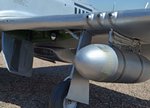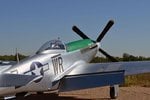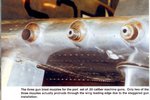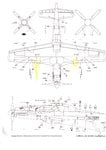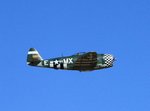Navigation
Install the app
How to install the app on iOS
Follow along with the video below to see how to install our site as a web app on your home screen.
Note: This feature may not be available in some browsers.
More options
You are using an out of date browser. It may not display this or other websites correctly.
You should upgrade or use an alternative browser.
You should upgrade or use an alternative browser.
P-51 rc plane restoration for museum and tribute to Bill Getz
- Thread starter davegee
- Start date
Ad: This forum contains affiliate links to products on Amazon and eBay. More information in Terms and rules
More options
Who Replied?- Thread starter
- #42
I do remember reading somewhere that the 110 gal tanks had the connections to the airplane on the aft part of the tank, so I made the connectors like those I saw on those photos. Very hard to find much info other than that on the technical aspects of these drop tanks.
davegee
vikingBerserker
Lieutenant General
Way cool!
Crimea_River
Marshal
Amazing work!
Airframes
Benevolens Magister
Beautifully done.
drgondog
Major
Dave - I have yet to see a WWII photo showing a connector imbedded in the underside of the leading edge of the wing. Logically it doesn't make sense to have any line running from leading edge to tank for fuel purposes, nor air bleed/pressurization. What purpose would they serve?
- Thread starter
- #47
Here are some pics I took today at a local park, free from distracting backgrounds like trash cans, houses, etc. This was the first time the whole "smash" was put together.
davegee
davegee
Attachments
- Thread starter
- #48
Hi Bill: I'm pretty sure this is accurate, at least for these 110 gal. tanks. I'll try to attach a couple of scans that show these attach points under the leading edge of the wings, between the outboard and middle guns. The smaller hole is in front of the larger hole for the respective sized pipes is in a teardrop shaped depression. I was looking through a couple of books, one being Walk Around P-51D by squadron/signal publications, and it show attach points where I have indicated. On the drawing, I have indicated with a yellow circle where you will see two tiny dots that I think represent the attach points for the lines.
I'm certainly no expert on this subject, but from the research I did, and consulting a pilot/owner of a real P-51, this seems to be the case where the lines were attached. It may have varied some when using other tanks, like the teardrop 75 gal or others used in the war, but it looks to me that in every photo or drawing I can find that shows them to some degree, there is an attach point in that area.
Without some handbook showing exactly how this plumbing works, I can only guess as to the true function of these two pipes in the one I used as my source for making the drop tank connections.
davegee
I'm certainly no expert on this subject, but from the research I did, and consulting a pilot/owner of a real P-51, this seems to be the case where the lines were attached. It may have varied some when using other tanks, like the teardrop 75 gal or others used in the war, but it looks to me that in every photo or drawing I can find that shows them to some degree, there is an attach point in that area.
Without some handbook showing exactly how this plumbing works, I can only guess as to the true function of these two pipes in the one I used as my source for making the drop tank connections.
davegee
Attachments
Crimea_River
Marshal
Great looking build Dave.
drgondog
Major
The recessed panel for the twin fuel line fitting is clearly about four inches forward of the pylon and both connectors are about 1-1" apart in-line w/bomb rack. This is clear for the D-25 and -30.
Interestingly enough there was a design change somewhere between the D-10 and the D-25. The P-51B/C and D-5 and D-10 has a single connector which ran from leading edge of the pylon down to the tank and appeared to connect to the 110 aft for the pylon. I have two distinct pictures showing the installation - in other words it is not a short/Straight drop from wing connector to leading fuel connector on the front of the 110 gallon tank.
Last edited:
drgondog
Major
- Thread starter
- #52
Hi Bill: great pics you posted there. I don't doubt there were many engineering changes done when you consider the vast amount of P-51s that were manufactured in such a short time. The pic of Man O' War shows the twin lines similar to the models and photos I used to base my fabrication on. It's amazing there are so many minor differences on just about every aspect of these, and other planes of that era.
Thanks for the great pics. They are really a gem.
dave
Thanks for the great pics. They are really a gem.
dave
drgondog
Major
Dave - it is funny - we (dad) owned a -25 and I never noticed that fitting (or sure as hell didn't remember). I also have a pic of the wing tank being installed from lower view and no obvious fitting location on the bladder - but I cant tell if it is a P-51A or B/C/D based on the photo.
Also interesting is that the early B/C/D/K through the P-51D-10 had what always appeared to be the 'hose' like attachment in the front of the pylon reaching back to the glass elbow/aft tank fitting, to the clear 'double line' attachment that alternatively went straight down to front tank fitting, or trailed along the pylon to the aft tank fitting..
Also interesting is that the early B/C/D/K through the P-51D-10 had what always appeared to be the 'hose' like attachment in the front of the pylon reaching back to the glass elbow/aft tank fitting, to the clear 'double line' attachment that alternatively went straight down to front tank fitting, or trailed along the pylon to the aft tank fitting..
Airframes
Benevolens Magister
There were difference in connection points to the tanks themselves, depending on whether 75 gal, or 108 gal, paper or metal, and which production source. One pipe is fuel feed, the other the pressure line.
Erich
the old Sage
Dave you are interested in P-47 groups do you know any of the guys in the 78th fg ? good thread guys
as a side note to what was said on page # 2 I think about US codes and that LW pilots may shy away from a possible US ace, well will tell you the LW pilots did not have time to get close enough to view a full-on US code, either they were blowing US bombers/fighters away with their heavy cannon or taking it in the shorts themselves from .50's.
as a side note to what was said on page # 2 I think about US codes and that LW pilots may shy away from a possible US ace, well will tell you the LW pilots did not have time to get close enough to view a full-on US code, either they were blowing US bombers/fighters away with their heavy cannon or taking it in the shorts themselves from .50's.
- Thread starter
- #56
There were difference in connection points to the tanks themselves, depending on whether 75 gal, or 108 gal, paper or metal, and which production source. One pipe is fuel feed, the other the pressure line.
Here is some interesting information on the operation of the drop tanks mechanically from someone out in California who owns, operates, and flies a P-51D I got in a recent email to him requesting more techical information on the drop tanks
:
Sorry for the late response concerning your question about the drop tanks. Bill forwarded your question to me and I can pass on what i know about the tanks. The lines you are describing on the tanks are for pressurizing the tanks and for fuel feed. They are aluminum lines and are connected with rubber hoses that allow the tanks to fall free from the wing when jettison. The tanks do not have pumps in them they are pressurized from the out flow side of the engine driven vacuum pump that provides vac for the flight instruments. There is is a matrix of lines and check valves between the engine and oil tank that split off and go through the wing wheel wells to the drop tanks. The tanks are plumbed through the fuel selector valve on the center console in front of the control stick. The fuselage tank was usually used first down to 25 gallons followed by the drop tanks. The P-51 could not do well in a dog fight with the fuselage tank full or with drop tanks. The tanks are jettisoned by pulling the respective handle in the cockpit that has a cable leading to the drop hard point hooks. I hope this answers your questions. If you have any others please feel free to e mail me and I will to my best to provide you with the information.
davegee
- Thread starter
- #57
Hi Erich: I don't really know any folks in the 78th FG other than Dick Hewitt, who flew both P-47s and P-51s with that august unit. Dick came to a couple of our r/c shows and one of our members made a great 1/5 scale flyable model of his P-47 in the green camo and black and white checkerboard cowl. Unfortunately, Dick has taken ill, I am told, but I hope he pulls through. I believe he is close to 90 years old now. Great guy. If I come across any folks more fluent in 78th FG info, I'll be happy to put you in touch with them. My favorite 8th AAF units were the 56th, 78th and 4th FGs. They were all great, but these were my favorites. I'll attach some pics of the r/c model of Dick's MX-E. Dick was present at this show about three years ago.
As far as getting close enough to see and understand the call signs for specific airplanes, I suppose that was in part a statement in jest by Bill. He didn't get to know Henry Brown until just a few years before Henry died, as Brown had gotten shot down and captured about the time Bill went to the operational 2nd Div. Scouting forces attached to the 355th FG at Steeple Morden. You're probably right, in most cases, you would never have the time or interest in ciphering squadron code letters when someone is firing several pounds of lead every second trying to kill you!!! (lol) davegee
As far as getting close enough to see and understand the call signs for specific airplanes, I suppose that was in part a statement in jest by Bill. He didn't get to know Henry Brown until just a few years before Henry died, as Brown had gotten shot down and captured about the time Bill went to the operational 2nd Div. Scouting forces attached to the 355th FG at Steeple Morden. You're probably right, in most cases, you would never have the time or interest in ciphering squadron code letters when someone is firing several pounds of lead every second trying to kill you!!! (lol) davegee
Attachments
Erich
the old Sage
Dave my interest in the 78th fg was the pilots that were engaged in combat with the Me 262, Dick H. being one of them, Dick and I go back a few years. was able to help ID Dick one of his last victories flying the 262 near Prague, when he shot down 2 of them but only given credit for one.
- Thread starter
- #59
Hi Erich: that is very interesting! Would you happen to be able to trace a possible kill/damage by Bill Getz on one of his Scouting missions? Bill got several hits on the plane, thought he might have shot it down, but we might never know for sure. He was given credit for the kill by his CO, but it was never officially recorded as a kill in the records. Since it never was official, Bill requested that I keep any kill markings off of the model of Saucy Shirley. At the least, Bill chased off and damaged a jet that might otherwise have created havoc amongst the bomber stream.
dave
dave
Erich
the old Sage
seriously Dave I have tried to check whom may have shot down whom....................this is crass sounding but good luck. with the increased speed rate flat out after attack even on US gun cams we cannot of course be sure if the jet was a firm kill or even just partially damaged to land at base the LW ground crews literally throwing patches on the jet for the next days ops. what can be confirmed is the lack of any details on any of the 262 LW jet units in book form even with the classic book by author Manfred Boehme and the man has a ton of resources he only gives just an inkling of the casualty rate in JG 7, also the wonderful multi-volumes on the 262 by Classic pubs, again we are guessing to some degree as to which jet and which pilot killed in action, wounded, bailed out or unhurt.
Users who are viewing this thread
Total: 1 (members: 0, guests: 1)


